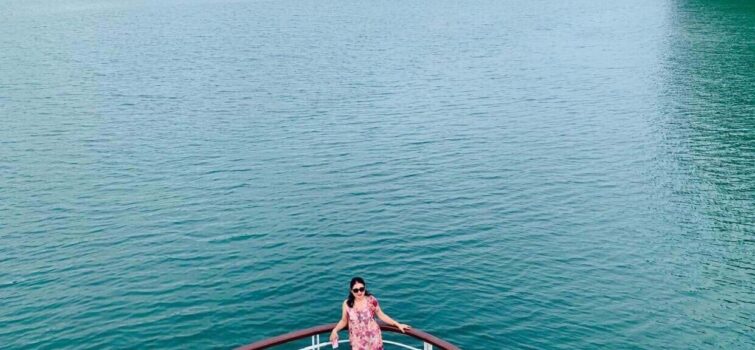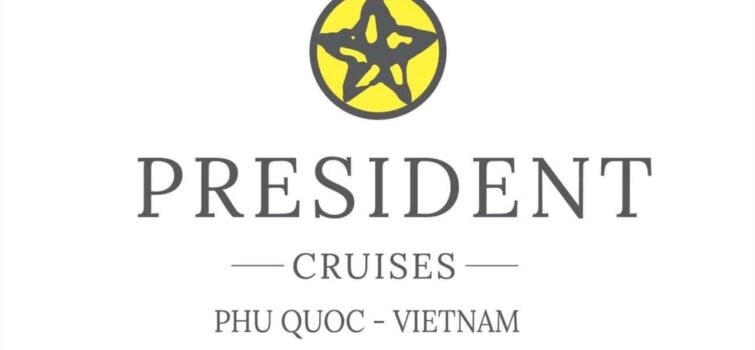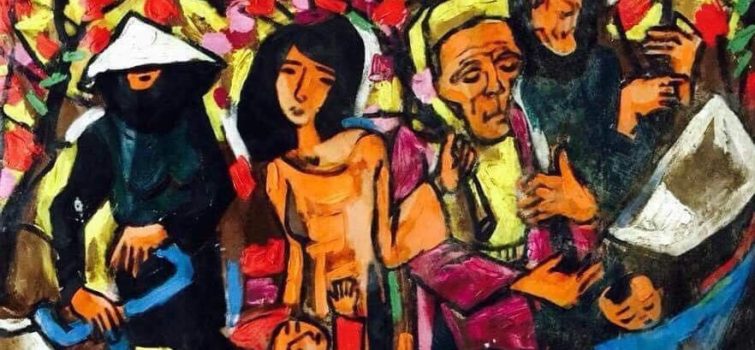Hàng không và Du lịch – đôi cánh để thu hút khách quốc tế đến Việt Nam
Hàng không và Du lịch – đôi cánh để thu hút khách quốc tế đến Việt Nam
Du khách bay tới Việt Nam cần trở nên dễ dàng hơn và giá cả hợp lý hơn. Khách du lịch đến cần được “vui vẻ”, được “chiều chuộng”, tận hưởng nhiều sản phẩm du lịch đa dạng và sáng tạo, đầy cảm xúc, từng điểm chạm đều mang lại sự hài lòng và tạo nên lượng khách chất lượng hơn.
Tuy nhiên, vấn đề đặt ra là tại sao ngành du lịch Việt Nam lại khó cạnh tranh so với các nước trong khu vực. Một trong các nguyên nhân đó là giá vé rất cao, do đó cần thiết lập mặt bằng giá mới. Ngoài ra, du lịch Việt Nam cần tập trung vào khách hàng và phát triển các sản phẩm trải nghiệm mới và sáng tạo, phù hợp với bản sắc dân tộc và đáp ứng nhu cầu của khách hàng.
Việc đổi mới và sáng tạo là rất cần thiết để đáp ứng sở thích của khách quốc tế và Việt Nam. Cần có chiến lược phát triển du lịch, thương hiệu, hướng tới chất lượng hơn số lượng. Đặc biệt, cần quản lý điểm đến tốt để phát triển bền vững.
Giá vé máy bay cao, ít lựa chọn cản trở khách du lịch đến Việt Nam
Đầu năm 2023, Lux Travel DMC – một thành viên của Lux Group đã có một đoàn khách Ý 30 người đăng ký tham quan Việt Nam trong 16 ngày. Tuy nhiên, giá vé máy bay quá cao và không có đường bay thẳng từ Ý đã khiến khách hàng quyết định không đi. Một đoàn khách khác từ nước Anh cũng đã phải từ bỏ kế hoạch du lịch Việt Nam vì giá vé máy bay quá cao, thay vào đó, họ đã chọn Thái Lan do đường bay thuận tiện và giá vé tốt hơn. Tôi đã đi công tác tại hội chợ WTM London và ITB Berlin và nhận thấy giá vé cao đã cao gấp đôi so với thời điểm trước năm 2019.
Để phát triển ngành du lịch Việt Nam, việc phát triển hệ thống hàng không là rất quan trọng. Việc hợp tác giữa các đối tác trong ngành du lịch như hàng không, lữ hành, khách sạn và các cơ quan quản lý điểm đến sẽ thúc đẩy phục hồi và phát triển ngành du lịch. Việc định vị Việt Nam là một điểm đến du lịch bền vững, kinh doanh du lịch phải được tử tế và cung cấp trải nghiệm độc đáo là cần thiết.
Việt Nam có bốn điểm mạnh về tài nguyên du lịch khác biệt độc đáo so với các nước trong khu vực là văn hoá, thiên nhiên, con người và ẩm thực. Tuy nhiên, cơ chế chính sách, chất lượng nguồn nhân lực, sản phẩm du lịch, xúc tiến, quản lý điểm đến và ứng dụng chuyển đổi số là những điểm yếu của Việt Nam hiện nay.
Để thu hút khách du lịch quốc tế đến Việt Nam, cần cấp thiết tháo gỡ các điểm nghẽn và xúc tiến hiệu quả. Định vị Việt Nam là một điểm đến di sản văn hoá và thiên nhiên là cần thiết. Trong đó, di sản là khác biệt và bản sắc của Việt Nam. Việc định vị và cung cấp trải nghiệm độc đáo sẽ giúp du khách đến Việt Nam có trải nghiệm tốt hơn và muốn quay lại nhiều lần.
Thu hút khách du lịch cao cấp bằng sản phẩm và dịch vụ chất lượng
Lux Group đã từng tung chiến dịch WOW Vietnam dựa trên những thế mạnh của đất nước mình để thu hút khách cao cấp tới Việt Nam. Chiến dịch này đưa ra bảy lý do VIETNAM mời gọi du khách tới thăm gồm: V – Varied landscape (Phong cảnh đẹp), I – Indigenous culture (Văn hoá bản địa đặc sắc), E – Exotic beaches (Bãi biển đẹp), T – Timeless charm (Vẻ quyến rũ vô tận), N – Natural heritage sites (Các di sản thiên nhiên), A – Ancient cities (Các đô thị cổ), M – Memories to cherish forever (Trải nghiệm đáng nhớ).
Dưới góc độ nhà đầu tư kinh doanh du lịch, du thuyền, nhà hàng và khách sạn, tôi cho rằng Việt Nam cần phát huy 9 chữ S để trở thành cường quốc du lịch:
- System (hệ thống): Hệ thống chính sách, bao gồm Bộ Du Lịch, đã gỡ bỏ các rào cản và thúc đẩy phát triển kinh tế du lịch, đóng góp hơn 10% vào GDP. Thị thực điện tử Việt Nam (E-visa) đã được áp dụng cho tất cả khách du lịch muốn đến thăm Việt Nam, miễn visa ít nhất 45 ngày và được phép nhập cảnh và xuất cảnh nhiều lần đối với các nước đã mở rộng miễn visa đối với các thị trường nguồn và tiềm năng như Mỹ, Canada, Úc, New Zealand, Đông Âu, Ấn Độ. Khách du lịch có thể lấy visa ngay tại cửa khẩu quốc tế (visa on arrival) một cách dễ dàng và thuận tiện. Điều đặc biệt là tạo điều kiện cho những người nghỉ hưu từ 50 tuổi trở lên có thể dễ dàng đến Việt Nam để tiêu tiền, mua nhà ngôi nhà thứ hai (second home) nghỉ dưỡng, chăm sóc sức khoẻ và sống tại đây.
- Sun, Sand, Sea, Sail (Biển xanh, cát trắng, nắng vàng và du thuyền): Việt Nam có rất nhiều tiềm năng cho du lịch biển với bờ biển dài hơn 3000km và hơn 4000 hòn đảo. Có tới 28 tỉnh thành có biển và 125 bãi biển đẹp được công nhận trên thế giới, như Nha Trang, Lăng Cô, Lan Hạ và kỳ quan vịnh Hạ Long. Tuy nhiên, để phát triển du lịch biển đảo, chính sách cho kinh tế du lịch cần được thay đổi để tạo điều kiện thuận lợi hơn cho tour biển đảo và tour trải nghiệm trên vịnh. Việc đơn giản hóa thủ tục hành chính và quy chuẩn theo tiêu chuẩn quốc tế là cần thiết. Hạ tầng cảng biển và tài nguyên du lịch ven biển cũng cần được quy hoạch và khai thác hợp lý hơn. Tập đoàn Lux Cruises Group (Emperor Cruises và Heritage Cruises) đã và đang khai thác trên nhiều vịnh đẹp của Việt Nam và đang phát triển đội tàu, nhưng vẫn còn nhiều rào cản về cảng biển và quy định hàng hải.
- Scenery (Cảnh quan): Tận hưởng khoảnh khắc đẹp tự nhiên bền vững, điểm đến không ô nhiễm, cung cấp trải nghiệm đáng nhớ, giúp du khách tận hưởng những cảm xúc phong phú và mang về những kỷ niệm đáng nhớ.
- Smile (Nụ cười): Nụ cười toả nắng của tất cả người Việt Nam, từ cánh cửa hải quan đến những người lái xe xích lô, các nhân viên trong ngành du lịch cần có thái độ, kỹ năng và hiểu biết để đem đến sự hài lòng cho khách du lịch.
Ngoài ra, #SMILE (Cười). SMILE: S – Bền vững (Sustainability) với chiến lược phát triển xanh, thân thiện môi trường; M – Nguồn nhân lực (Manpower) với mục tiêu nâng cao kỹ năng của lực lượng lao động du lịch lên tiêu chuẩn quốc tế; I – Kinh tế bao trùm (Inclusive Economy) bảo đảm các hoạt động du lịch và vì du lịch, tính tới du lịch; L – Bản địa hóa (Localisation) trong đó đưa nét độc đáo của mỗi cộng đồng làm điểm thu hút du lịch; E – Hệ sinh thái (Ecosystem) tận dụng hệ sinh thái du lịch và kết hợp du lịch và nông nghiệp.
- Service (Dịch vụ): Thái độ + trình độ phục vụ + quy trình hiệu quả. Thái độ chiều khách của nhân viên du lịch rất quan trọng để gây ấn tượng đẹp với khách hàng và giúp họ quay lại nhiều lần. Điều này làm cho kinh tế du lịch tử tế, từ tâm và hiếu khách. Ngoài ra, quy trình phục vụ hiệu quả cũng rất quan trọng để đảm bảo chất lượng dịch vụ được cung cấp tốt nhất cho khách hàng.
- Shopping (Mua sắm): Việt Nam cần phát triển nhiều trung tâm mua sắm chuyên dụng cho hàng hóa cao cấp, các thương hiệu có hoàn thuế. Nên sản xuất các sản phẩm bản địa cao cấp, thủ công mỹ nghệ, thời trang, nông sản cà phê, trà xuất khẩu tại chỗ để thu hút khách hàng. Khách hàng muốn mua sắm những sản phẩm cao cấp nhưng vẫn tiếp tục mua sắm mà không bị cạn túi tiền.
- Sex (Tình dục): Khu vực đèn đỏ có giấy phép và được quản lý chặt chẽ, đảm bảo bảo vệ quyền lợi của người lao động. Đây cần trở thành một nghề hợp pháp, không bị cấm đối với khách hàng có nhu cầu sử dụng, dù nhiều đại biểu Quốc hội đã đề xuất hạn chế.
- Social Innovations (Cải tiến xã hội): Luôn đổi mới sáng tạo, số hoá vị nhân sinh và trải nghiệm khách du lịch, phục vụ thống kê, hoạch định chuẩn chiến lược, chấm dứt ước lượng, ước chừng, khoảng….
Khai mở và nâng tầm di sản Việt là điểm nhấn về du lịch trải nghiệm di sản văn hoá và thiên nhiên, đặc trưng và khác biệt nhất của Việt Nam. Điều này sẽ tạo ra giá trị mới, trải nghiệm đầy cảm xúc, bản sắc và tự hào dân tộc, thu hút du khách cao cấp trong và ngoài nước. Du lịch là để khám phá, học hỏi, tôn vinh, vui chơi và tận hưởng!
Mỗi điểm đến đều mang những bí mật, câu chuyện, kho báu về ẩm thực, thiên nhiên, văn hóa, nghệ thuật, di sản, lịch sử và con người của địa phương. Đó chính là điểm lôi cuốn du khách đến để khám phá, tận hưởng, thư giãn, hòa mình vào di sản văn hoá và thiên nhiên.
Khi đến Việt Nam, du khách không ngừng tìm kiếm những trải nghiệm mới lạ và độc đáo, khám phá văn hóa địa phương và hòa cùng người dân để tận hưởng vẻ đẹp của đất nước và con người nơi đây. Chính văn hóa Việt Nam sẽ làm nên sự khác biệt trong hành trình du lịch trải nghiệm của mỗi du khách.
Di sản là sự khác biệt độc đáo có bản sắc của du lịch Việt Nam.
Cultural Tourism – Du Lịch Văn Hoá theo định nghĩa trên Wikipedia, là một hoạt động du lịch để du khách học hỏi, khám phá, trải nghiệm và tận hưởng những giá trị văn hóa hữu hình và vô hình của điểm đến du lịch.
Sự lôi cuốn và sự hấp dẫn của sản phẩm du lịch của điểm đến là những hiện vật, sản phẩm trí tuệ, tinh thần và giá trị cảm xúc của một cộng đồng xã hội, bao gồm nghệ thuật, kiến trúc, lịch sử, di sản văn hóa, ẩm thực, văn chương, âm nhạc, sáng tạo công nghiệp và hành vi lối sống, hệ giá trị niềm tin và truyền thống văn hoá.
Du lịch di sản là một phần của du lịch văn hóa. Theo định nghĩa của Tổ chức Bảo tồn Di sản Lịch sử Quốc gia Hoa Kỳ, “Du lịch di sản văn hóa là du lịch để trải nghiệm điểm đến, hiện vật, các hoạt động thể hiện chân thực những câu chuyện và con người xưa và nay, nó bao gồm văn hóa, lịch sử và tài nguyên thiên nhiên”.
Di sản thiên nhiên – đường thủy, cảnh quan, rừng cây, đầm lầy, vùng cao, động vật hoang dã bản địa, côn trùng, thực vật, cây cối, chim và động vật. Di sản văn hoá hữu hình – các di tích lịch sử, tòa nhà, tượng đài, đèn biển, hiện vật trong viện bảo tàng và kho lưu trữ…
Di sản phi vật thể – phong tục tập quán, thể thao, âm nhạc, khiêu vũ, văn hóa dân gian, câu chuyện, hàng thủ công mỹ nghệ, kỹ năng và kiến thức bản địa.
Hiện cả nước có khoảng 40.000 di tích được kiểm kê. Trong đó, hiện có khoảng 10.000 di tích được xếp hạng cấp tỉnh, thành phố; trên 3.460 di tích cấp quốc gia; 107 di tích quốc gia đặc biệt, 164 bảo vật quốc gia.
Có 8 di sản được UNESCO công nhận là Di sản Văn hóa và Thiên nhiên thế giới và 14 di sản được UNESCO công nhận Di sản Văn hóa phi vật thể của nhân loại. Trong Chương trình Ký ức thế giới của UNESCO, Việt Nam có 7 Di sản tư liệu được UNESCO ghi danh. Ngoài ra, Việt Nam còn có 9 khu dự trữ sinh quyển thế giới.
Việt Nam cần định vị điểm đến là di sản hàng đầu Châu Á
Người Việt Nam sẽ trân quý giá trị di sản và khám phá 53 tỉnh thành đi hết đất nước khám phá. Du khách nước ngoài tìm tòi, mộng mơ, khám phá, thư giãn, trải nghiệm, tôn vinh con người Việt Nam, hoà mình vào văn hoá và thiên nhiên. Những di sản văn hoá và thiên nhiên cần phát huy giá trị di sản, nâng tầm, sáng tạo những trải nghiệm mới. Không những nâng cấp làm đẹp điểm đến để du khách đến thăm và nơi đáng sống cho người dân bản địa. Không ăn mày di sản mà sáng tạo di sản tạo nhiều trải nghiệm du lịch giầu cảm xúc và đáng nhớ cho lữ khách.
Tôi kiến nghị riêng cho Khánh Hoà, di sản biển đảo nghỉ dưỡng biển làm thương hiệu du lịch THIÊN ĐƯỜNG BIỂN ĐẢO hơn cả Phú Kẹt (Thái Lan) hay Bali (Indonesia), muốn vậy phải giữ sạch môi trường, biển đẹp, hài hoà kiến trúc và cảnh quan, ngừng tàn phá huỷ hoại di sản vật thể, bảo tồn và phát huy di sản biệt thự Bảo Đại, không xây dựng trên đảo hòn Một và bảo tồn san hô và hệ sinh thái dưới nước xung quanh hòn Mun.
Việt Nam cần xây dựng hệ thống cảng biển du lịch cho tàu quốc tế đến, sao cho các tàu siêu lớn (mega ship) vào cảng được không phải tăng bo như hiện nay và các tàu mang cờ Việt Nam chạy vùng cận duyên, nối Đà Nẵng – Nha Trang, Sài Gòn – Nha Trang bằng thuỷ lộ, kết nối nội thuỷ các vịnh Vân Phong với Nha Trang bằng đường thuỷ một cách dễ dàng, hút khách ở lâu hơn, đa trải nghiệm, chi tiêu tiền nhiều hơn.
Khẩn trương đưa kinh tế ban đêm vào hoạt động với nhiều trải nghiệm, khách có cái tiêu tiền hầu bao du khách mở nhiều hơn từ 6h tối tới 6h sáng, du thuyền chạy ban đêm không giới hạn giờ phải về bến. Cho phép ngủ đêm trên vịnh Nha Trang và Vân Phong bà cả 2 vịnh một hải trình, đa dạng hoá sản phẩm trải nghiệm và không tập trung vào một nguồn khách. Cần rút ra bài học về quản lý điểm đến, có ý kiến vai trò hiệp hội du lịch và các DMO tại Nha Trang hoạt động rất tốt. Mở ra những thị trường mới, Úc là thị trường mới cho DL Khánh Hoà nếu có bay thẳng, các nước nói Tiếng Nga ngoài Ucraine và Nga. Hàng không mở lối trước kết nối nhà nước, nhà hàng, nhà xe, nhà cung cấp, nhà tàu du lịch khi phát triển thị trường mới, fam trip, pres trip và bán ngay được sản phẩm và đảm bảo được sản phẩm bán chuỗi liên kết vốn là điểm yếu của DL Việt Nam!.
Hiện nay khách du lịch có xu hướng tìm điểm đến mới cho thị trường mới, mùa du lịch mới ngoài mùa cao điểm để du lịch quanh năm, khách quen tìm sản phẩm mới, du lịch theo chủ đề mà Nha Trang Khánh Hoà nhiều lợi thế như Golf, Mice, wellness chăm sóc sức khoẻ toàn diện, du lịch thể thao, mạo hiểm, phim trường, cruise và yacht du thuyền, du lịch sang trọng luxury hút khách cao cấp.
Vĩ thanh
Việt Nam cần thực hiện cạnh tranh bằng chiến lược kết nối hàng không tốt, gỡ các rào cản, đưa ra nhiều trải nghiệm du lịch đa dạng cho du khách về thân, tâm và trí tuệ, đảm bảo có nguồn lao động có chất lượng cao và được đào tạo tốt, có thái độ, kỹ năng và hiểu biết tốt về ngành du lịch. Để làm mới ngành du lịch, Việt Nam cần có chiến lược thương hiệu quốc gia, thay đổi logo và bộ nhận diện mới, xác định điểm mạnh của ngành du lịch và đưa ra chính sách visa đột phá, có tư duy mới về kinh tế du lịch, kết nối hàng không và lữ hành có chính sách phục hồi ngắn, trung và dài hạn.
Để đạt được mục tiêu đón 8 triệu khách mới vào năm 2023 và biến Việt Nam thành quốc gia du lịch hàng đầu Châu Á vào năm 2030, cần thành lập một ban chuyên trách chịu trách nhiệm và được chỉ đạo trực tiếp bởi Thủ tướng để gỡ bỏ những khó khăn trong ngành du lịch, khách sạn và hàng không, đưa ra quyết sách nhanh chóng để phát triển ngành kinh tế này. Đồng thời, cần có ban điều hành và chịu trách nhiệm mới để thay đổi cục diện và đạt được mục tiêu nói trên.
Phạm Hà
Chủ tịch kiêm CEO
Lux Group
Email: ceo@luxgroup.vn
0912303096
Sailing the Coastline of Vietnam
Added two cruises under Emperor Cruises Brand for Nha Trang and Phu Quoc, Lux Cruises Group Is Developing A Fleet Of Two Luxury Vessels and Attending ITB Berlin 2023.
The marine tourism sector, which is a top priority of the country’s sea economy Master Plan 2030-45, has been struggling to attract investment in cruise harbours and coastal infrastructure to lure globally branded cruise fleets connected with worldwide destinations. Cruise services are one of the key products in building marine tourism as a core part of the ‘blue sea economy’ plan.
The coast of Vietnam is ranked the 33rd in the world. This nation ranks in the top 12 countries for the most beautiful bays in the world including Halong, Lan Ha, Lang Co and Nha Trang. Although Vietnam has 3,260 km of coastline, 125 world- class beautiful beaches, 3000 islands, and 28 coastal cities, it still does not have a cruise ship fleet. Vietnam must have cruise ships along the coast and to carry passengers from Vietnam to other countries.
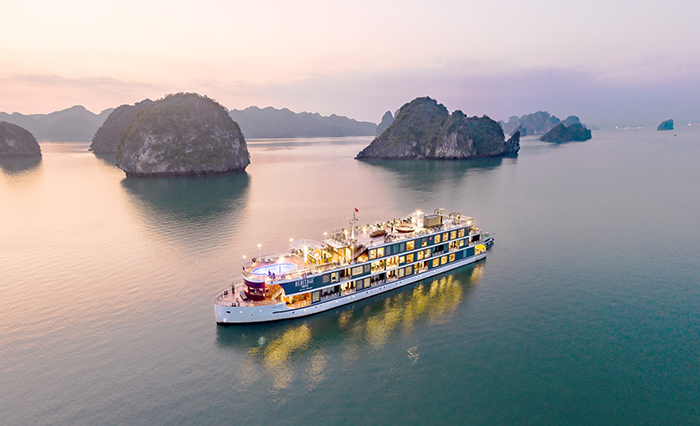
Making a 67.3 per cent share of the country’s total tourism revenue, a top favourite ocean destination among 156 beach nations, cruise tourism in Vietnam has not been promoted properly so far. The number of cruise tourists accounts for only 2-3% of the total number of international visitors to Vietnam.
Lux Group’s Founder and CEO Pham Ha emphasized that it is necessary to attract investors to invest in cruise ships and yachts with Vietnamese nationality that run along the coast. Be the first to cruise along Vietnamese coast in 2025!
Lux Cruises (www.lux-cruises.com) is a member of Lux Group (www.luxgroup.vn), an award-winning Asian travel and hospitality group with more than 20 years delivering authentic and unique experiences.

Lux Cruises is a combination of 6 cruises, tenders, speedboats under two brands, Emperor Cruises (www.emperorcruises.com) and Heritage Cruises (www.heritagecruises.com), operating in the most scenic bays and archipelagos of Vietnam: Halong Bay, Bai Tu Long Bay, Lan Ha Bay (Cat Ba Archipelago), Nha Trang Bay and Phu Quoc Archipelago.
“Our vision is to start our first expeditions on the Gulf of Tonkin and further expand between Hanoi Capital and Halong Bay on the Red River and its tributaries, along the coastline of Vietnam, on the Mekong River and to other Southeast Asia countries” said Pham
Ha “Lux Group Is Developing A Fleet Of Two Luxury Vessels in 2025 if you interest in our iconic products and investment opportunities, visit our Vietnam Pavillon at ITB Berlin 2023”.
“The Lux Yacht Collection represents the next chapter of our long history of industry-leading innovation, and a milestone moment for our company as we continue to capitalize on new opportunities.” says Lux Group Founder and CEO Pham Ha.
Details surrounding the first superyacht SPIRIT and PRESIDENT of the LUX Yacht Collection reveal about 99 suites and duplex suites, a spa, a salon, several bars/restaurants, a gym, a huge infinity swimming pool, and an outdoor movie theater. To ensure guests’ needs are attended to, there will be enough staff to assist them with personalized services.
Heir to the legacy of Vietnam’s king of ships: Sea tourism and expectations for a ‘made in Vietnam’ fleet.
The marine tourism sector, which is a top priority of the country’s sea economy Master Plan 2030-45, has been struggling to attract investment in cruise harbours and coastal infrastructure to lure globally branded cruise fleets connected with worldwide destinations.
Cruise services are one of the key products in building marine tourism as a core part of the ‘blue sea economy’ plan.
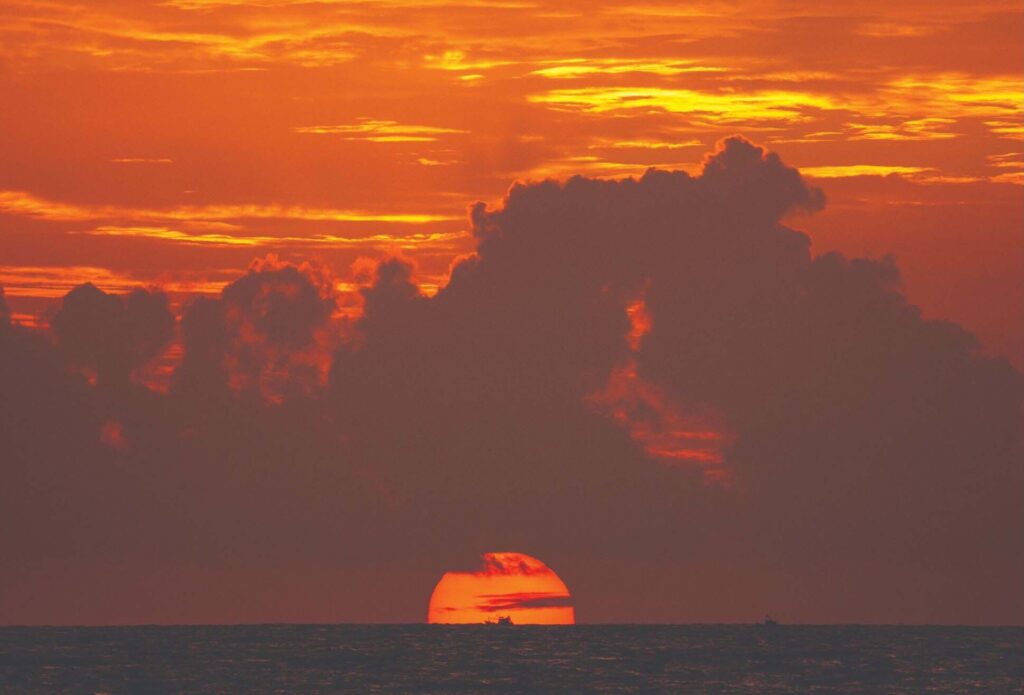
“The number of cruise tourists accounts for only 2-3% of the total number of international visitors to Vietnam. With a long coast and beautiful beaches, Vietnam has become a destination for international cruise vesels. Almost all cruises have to dock at cargo ports in Vietnam, while international standards for entertainment and free-duty shops at arrival ports have yet to be developed,” Pham
Ha President and CEO Lux Cruises Group said.
The number of cruise travelers to Vietnam are increasing, and cruise ships to the country are getting bigger, carrying up to 4,500-4,800 passengers. The time of stay at Vietnamese ports is also longer, and they stop at more ports instead of only 1-2 ports as before. However, the number of cruise tourists accounts for only 2-3% of the total number of international travellers to Vietnam.
Pham Ha said sea tourism is still dealing with barriers that have blocked business and kept investors at bays such as Nha Trang, Lan Ha, Ha Long Bay, Phu Quoc Islands for decades. There are bottlenecks for tourism businesses and investors were the legal framework, destination management and poorly linked tour services among the 28 coastal provinces. Cruise tourism in Vietnam has not been promoted properly.
Although Vietnam has 3,000km of coastline, 125 world- class beautiful beaches, 3000 islands, and dozens of coastal cities, it still does not have a cruise ship fleet. Vietnam must have cruise ships to carry passengers from Vietnam to other countries. Pham Ha, emphasized that it is necessary to attract investors to invest in cruise ships and yachts with Vietnamese nationality that run along the coast.
“Adventurous beach sports, diving, kayaking, fishing, night art performances and entertainment should be included for local cruise fleets, while preferential policies are needed for investors in infrastructure, ship building and cruise ports, Ha added.
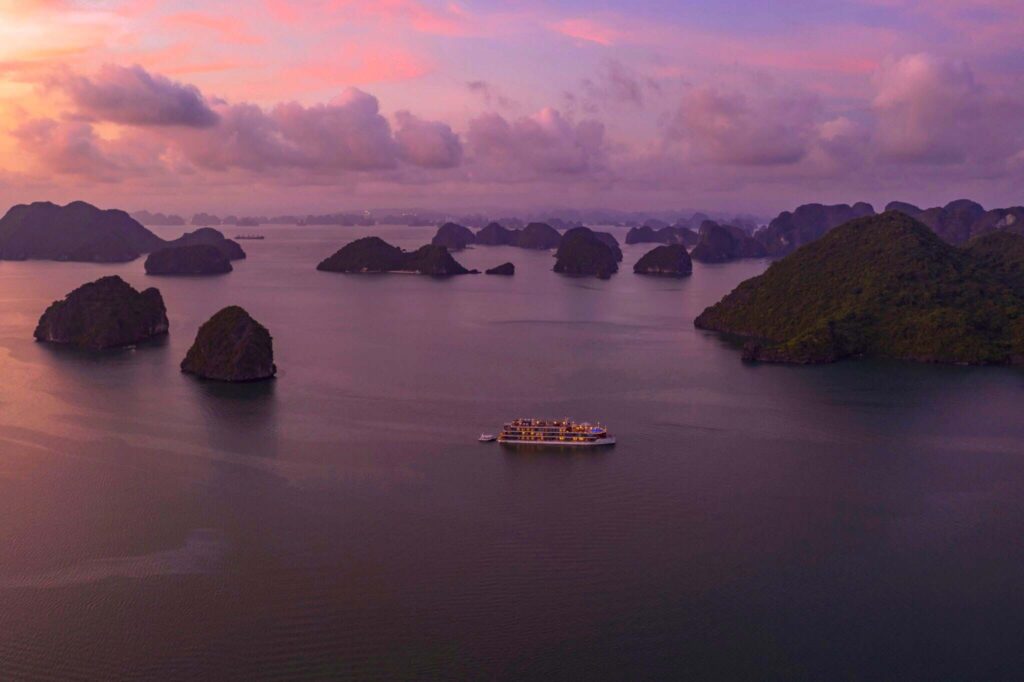
Lux Cruises Group is positioning as Vietnam’s most luxurious cruise line.
Blessed with geographical location, climate, and natural resources, Vietnam has shown plenty of potential for developing tourism. With more than 3,000 km of coastline covering green forests and majestic landscapes, this nation also boasts about 125 beaches and ranks in the top 12 countries for the most beautiful bays in the world. 70% activities come from maritime tourism.
Promoting island and sea tourism development is what Vietnam Tourism Board has mainly focused on. “We used the seven letters of the country’s name: V – Varied landscape, I – Indigenous culture, E – Exotic beaches, T – Timeless charm, N – Natural heritage sites, A – Ancient cities, M – Memories to cherish forever”. Concludes Pham Ha
Therefore, LUX CRUISES would like to be a part of this mission to dedicate to inspiring the beauty of Vietnam to many more international partners, customers, and friends. Lux Cruises, a member of Lux Group, was founded in 2004 operating chiefly in ultra-luxury and luxury cruise and travel services. The Lux Cruises Group aims to build made-in-Vietnam’s most luxurious cruises fleet serving different bays and islands along the coastline of Vietnam.
Inspired by the spirit and the ambition of Vietnamese entrepreneur Bach Thai Buoi, who was very famous for his patriotism and business success in the early 20th century, Pham Ha built up his brand Heritage Cruises in 2019. This luxury cruise line has now two brands: Emperor Cruises and Heritage Cruises. Each cruise ship is artwork with stunning design and delightful services delivered by their enthusiastic award-winning team since 2014.
Lux Cruises to launch brand new super yacht,
President Cruises and Yacht in 2025 for expedition along the coast of Vietnam
President Cruises’s sleek design, soothing and neutral hues, and contemporary layout were thoughtfully crafted to appeal to a clientele who is seeking relaxation, serenity, and the service they’ve come to expect from the brand.
First and foremost, guests are more than pleased with the ample amount of space both in their suites (purposely not referred to as cabins) as well as across the expansive and numerous common areas of this 190-meter vessel.
The company promiss more square footage per passenger and with just 150 suites and a passenger count of more than 300 for over night and 1000 víitors for a day, guests on board the first sailing were happily surprised with the room to stretch out.
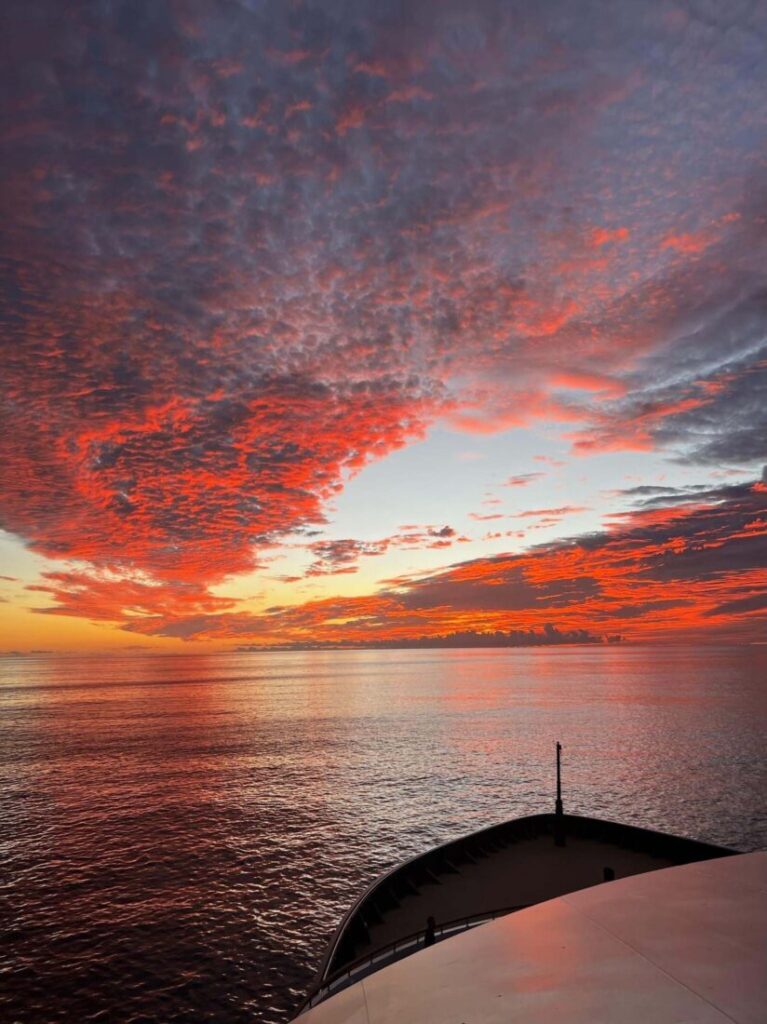
The first made-in-Vietnam mega yacht is stunning, truly a floating work of art, featuring spacious suites that all offer balconies and high ceilings, 5 dining venues, various inviting common areas, multiple pools (including an infinity one), a handful of whirlpools, a spa, fitness center, cigar lounge, and watersports marina. www.lux-cruises.com
Investment, better legal framework needed for cruise growth
A cruise docks at Đà Nẵng’s Tiên Sa Port on a tour in Việt Nam. The country’s cruise industry has not yet invested enough to make it a top destination in Asia and the world. VNS Photo Công Thành
ĐÀ NẴNG – The marine tourism sector, which is a top priority of the country’s sea economy Master Plan 2030-45, has been struggling to attract investment in cruise harbours and coastal infrastructure to lure globally branded cruise fleets connected with worldwide destinations.
Chairman of the Việt Nam Tourism Association Vũ Thế Bình said cruise services are one of the key products in building marine tourism as a core part of the ‘blue sea economy’ plan.
Bình said sea tourism is still dealing with barriers that have blocked business and kept investors at bay for decades.
He said bottlenecks for tourism businesses and investors were the legal framework, destination management and poorly linked tour services among the 28 coastal provinces.
Vũ Duy Vũ, a senior expert of cruise service from Sài Gòn Tourist agency, said less complicated visa arrival procedures, upgrading ports and a highway system connecting ports and destinations are necessary for the cruise industry to thrive.
“Almost all cruises have to dock at cargo ports in Việt Nam, while international standards for entertainment and free-duty shops at arrival ports have yet to be developed,” Vũ said.
“Representative offices of the country’s tourism industry are not available at key cruise markets such as the US, Australia and EU,” he said.
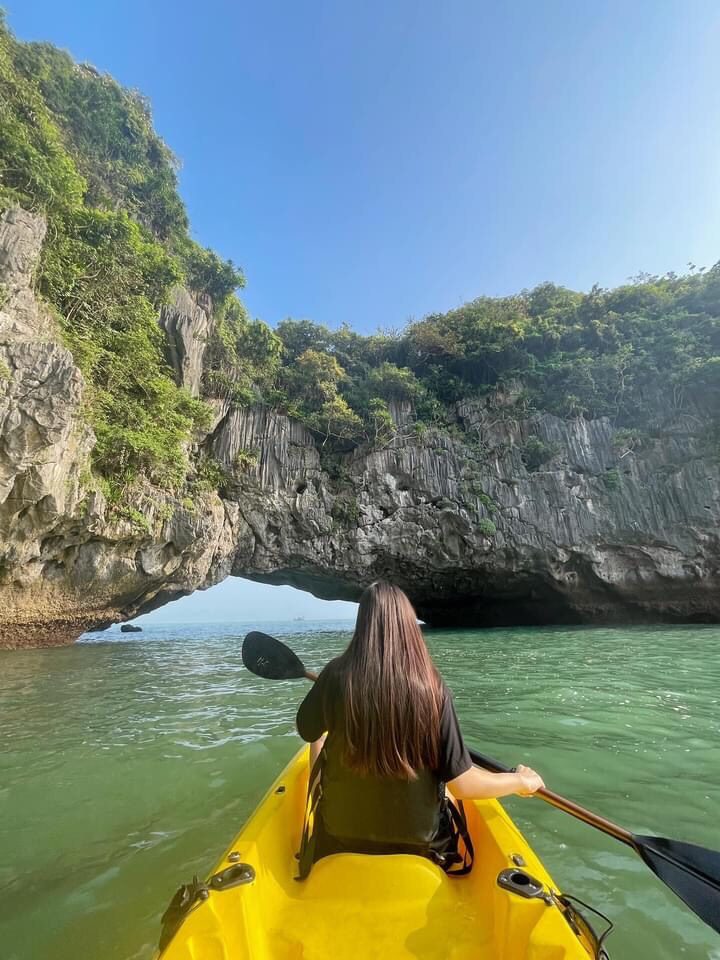
A tourist enjoys kayaking in Hạ Long Bay during a cruise tour in Quảng Ninh. More services and entertainment are needed for cruise growth in Việt Nam. Photo courtesy of Phạm Hà
Phạm Hà, CEO of Lux Group, said the port system from Hải Phòng to HCM City was poor quality and could not handle giant luxury or middle class cruise ships.
Hà said his own ship in Hạ Long Bay needs permissions from 18 local authorities to offer on-board night-stay service, while the group’s Emperor Cruise in Nha Trang had to get an international travel certificate to host dinner on board as ordered by the local tourism authority.
He explained that tourists on his cruise had to transship to visit Lan Hạ Bay in neighbouring Hải Phòng after finishing a tour in Bái Tử Long in Hạ Long Bay of Quảng Ninh province.
Hà said a one-stop procedure and GPS control given by port authorities of Quảng Ninh and Hải Phòng can help cruises exchange tour service at both bays.
Vũ Văn Đảo, director of Vũng Tàu Marina, a ship building company, said his company had to close in 2020 due to regulations on ship management and registration.
He said his 20-seat ships using Copolymer Polypropylene Polystone (PPC) from Europe were not registered for operation as no regulations on new materials for ship building existed.
Đảo said his new double-hull sailing boat design was used for hosting sailing festivals, but was refused by the local industrial park management board.
Flexible and quick responses are needed from local administrations to support the tourism business, he said.
Phạm Ngọc Thủy, director of Quảng Ninh provincial department of Culture, Sports and Tourism, said every local destination should build their own unique product that would help keep cruise visitors in Việt Nam longer.
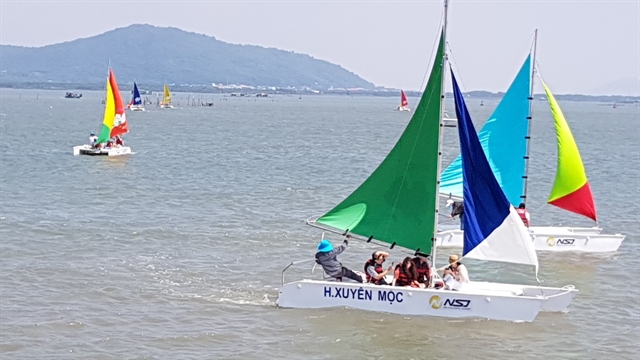
A sailing race is organised in Bà Rịa-Vũng Tàu. The service is rarely offered in coastal provinces and cities serving cruises in Việt Nam. Photo courtesy of Vũng Tàu Marina
Quảng Ninh is a rare locality investing in ports for cruise ships, while Đà Nẵng has begun changing dual-use Tiên Sa Port for cruises only.
Thủy said local ports could be built to link cruise tour services with ports in Singapore and East Asia or Southeast Asia for wider options in different countries and destinations.
Adventurous beach sports, diving, kayaking, fishing, night art performances and entertainment should be included for local cruise fleets, while preferential policies are needed for investors in infrastructure, ship building and cruise ports, Hà added. — VNS
Cong Thanh – Vietnamnews.vn
Time of my life
Pham Ha Founder and CEO of Lux Group (www.luxgroup.vn) reminisces about the Tet holidays, the most important festival in the Vietnamese calendar, and their importance.
Memories of past Tet holidays always come flooding back as the old Lunar Year comes to an end.
Tet during my childhood years meant eating well. The Lunar New Year in Vietnam is a time for family, both living and deceased, as people also invite their ancestors to Tet feasts. Activities have changed over time, but certain traditions are still followed by every Vietnamese family. It’s not only an occasion to decorate the home and shop for special goods, but also a chance for family members to reunite and pay their respects to those who came before them. Time flies but memories remain.
Tet Market
No matter who you have become, the first 21 years of your life are the most memorable. Life for me began in the countryside, in the heart of the Red River Delta, cradled in village culture and ancestral traditions. Today, in my rich collection of artworks from the famous artist Pham Luc, there is one beautiful piece depicting a Tet market that still holds deep meaning for me.
It represents one of my fondest memories as a child during Tet. The artwork is signed 1975, or ‘At Mao’ (Year of the Cat), the same year I was born. Vietnam’s north and south had just been reunified as brush met canvas, and while I didn’t witness the war I saw its consequences, which lasted until the US lifted its embargo in 1990.
Pham Luc’s Tet piece depicts the beauty of a busy rural market on the last day of Tet preparations in the north of Vietnam. People are wearing their best clothes or the traditional áo dài. Some clearly came from afar by bicycle. The happiness on their faces expresses their excitement at buying a peach blossom branch or cumquat tree to take home for Tet. The only young lady in the painting symbolizes spring, youth, and feminine beauty, while the young boy holding on to her seems to incessantly seek attention.
I can envision myself as this playful child, excited to be at the Tet market. I would know my parents were planning to buy me new clothes, that food would be abundant at family gatherings, especially because of my uncle’s return from Hanoi, and that I would also receive some lucky money.
In Vietnamese culture and life, the marketplace is also a meeting place, not simply a trading point. Communities chose to set up markets to connect, look for friends or life partners, or simply to have fun. There is always a lot of excitement and joy associated with the marketplace environment and Tet is an excellent time to embrace it.
As part of Tet preparations, everyone is in a rush to get a haircut, buy new clothes, visit friends, and stock up on traditional Tet delicacies. Businesses hang festive red banners that read ‘Chuc Mung Nam Moi’ or ‘Cung Chuc Tan Xuan’ (Happy New Year) and the market is adorned with colored lights.
Stalls spring up all over the village selling mứt (candied fruit and jam), traditional cakes, and fresh fruit and flowers. People bring flowering peach trees into their homes, which symbolize life and good fortune and celebrate the coming of spring.
Best Bánh Chưng ever
I remember I was about ten when my parents let me wrap a bánh chưng (square glutinous rice cake) in coconut palm leaves for the first time. I spent the whole night cooking with them; an experience I’ll cherish forever.
Preparing bánh chưng often involves the entire family. It’s a time-consuming process so requires the joint efforts of several people. The main ingredients are glutinous rice, pork, and green beans, wrapped square in broad-blade leaves that give the rice a green color after boiling. My grandfather, parents, and three brothers and sisters used to sit around the pot chatting while the bánh chưng cooked. We stayed awake until they were ready, which can take about 12 hours, eager to have a bite.
Bánh chưng has become the most famous traditional Vietnamese food when welcoming guests during the Tet holiday. They will often ask how many bánh chưng we cooked as a measure not only of how big this year’s celebrations will be, but also of the family’s financial situation.
Worshipping Ancestors and Tet Eve
Most Vietnamese people believe that the spirits of their ancestors live alongside all who are living. Homes, businesses and offices all have a shrine dedicated to the deceased that is carefully tended throughout the year, with food being offered, incense lit, and special paper offerings burnt.
At Tet, this custom becomes even more important, as the family prepares to invite their ancestors to eat with them. Before the big holiday, family tombs are visited, weeds are cleared away, and any needed repairs done.
On the first day of Tet, special offerings of elaborately decorated paper, fruit, food, and wine are made to the ancestors and left on the altar until the fourth day. On special occasions like death anniversaries or Tet, special rituals are performed to communicate with the dearly departed.
The ‘five-fruit tray’ placed on the ancestral altar during Tet symbolizes admiration and gratitude towards Heaven and Earth and the ancestors, demonstrates people’s desire for a life of plenty, and reminds them that ‘When eating the fruit, think of the grower’.
We would all wait impatiently for ‘Giao Thua’ (Tet Eve), when the old year becomes the New Year. It’s commonly believed among Vietnamese that in Heaven there are 12 Highnesses tasked with monitoring and controlling affairs on earth, with each taking charge for one year at a time.
Giao Thua is also the time to send off the old ‘Highness’ and welcome the new one. I remember my grandfather, being the oldest in the family, would practice the ceremony with simple offerings. We all then received best wishes from family elders and waited for the first guests to visit, known as xong dat (first visit to a land). Traditionally, the first person to visit the home in the New Year must be a family member with a pure soul and genuine nature.
Over the following few days, it was crucial for me to visit as many of my relatives as possible as well as friends and former teachers. As an old proverb has it, ‘The first day of Tet is for visiting the father’s family, the second day the mother’s family, and the third day for teachers’.
New Year and Ancient Customs
After growing up in a village, life drastically changed for me once I began to attend university. Later, as a promising student, I went to study in France in the mid-1990s. It was not always an easy time. Some years I could not return for Tet and spent this special time of year at Besançon, near the Swiss border, enduring the snowy weather and wishing I could be home with my family.
On the 23rd day of the 12th lunar month, expect to see women in traditional conical hats selling goldfish from the back of motorbikes, families placing meals and pieces of elaborately decorated paper on small tables in front of their homes, and women and young couples releasing goldfish into any open body of water. As soon as the ceremony of freeing the fish is over, the family cleans the kitchen, polishing every utensil in preparation for the return of the Kitchen God.
In Hanoi, on the stroke of midnight, the whole family sits down to eat together. The family altar is decorated with fresh flowers, fruit, and red candles. Most Hanoians visit pagodas and make sure they have a leafy branch in the home; an ancient symbol of prosperity.
In the central region, people put a lot of energy into Tet preparations, baking biscuits and sweets for months beforehand.
The people of Hue in particular, are famous for their delicious food, cakes, and jam. Some people hire boats and drift down the Huong (Perfume) River reciting poetry that recalls olden times and setting candles afloat on the water.
Tet in Saigon is more vibrant, with friends getting together to have fun. People also visit pagodas, carrying huge sticks of incense or candles. The free and easy Saigonese are not as bound by tradition as their northern cousins. Many take their families to the beach or amusement centers as well as pagodas. Most shops stay open, and shopping is a popular pastime. Just like elsewhere, though, Saigonese never forget to wish one another all the best for the new year.
The year begins at the beginning of the second moon, after the winter solstice. The lunar year has 12 moons and a lunar month lasts 29 and a half days, and we add one month, every three or four years, to the third or fourth lunar month. www.luxtraveldmc.com
###
Heritage Cruises Binh Chuan Cat Ba Archipelago
Vietnam’s first boutique cruise brings heritage alive
Contact us 24/7: 886036668
E: heritage@luxcruisesgroup.com
W: www.heritagecruises.com
P: (+84)24 3223 9988 Hotline 24/7: (+84)88 603 66 68


